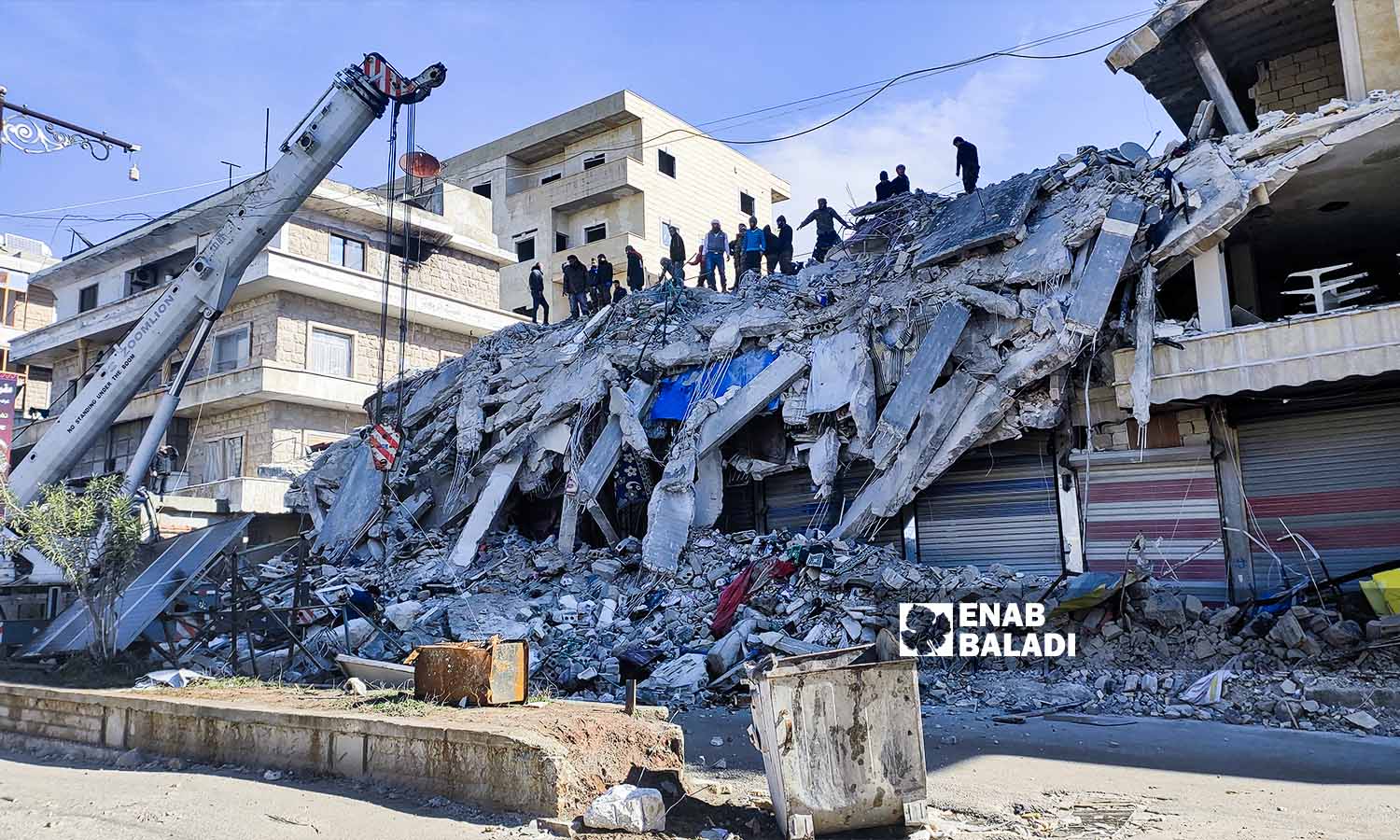


Volunteers and civilians in northwestern Syria try to rescue the injured and retrieve victims from the rubble in Salqin following the Feb. 6 earthquake - February 7, 2023 (Enab Baladi/Mohammad Nasan Dabel)


Jana al-Issa | Hassan Ibrahim
The earthquake that struck southern Turkey and four Syrian governorates was a defining moment in the lives of Syrians. “The disaster of the century” left damages still present to this day and painful details in the memory of the survivors. It resulted in the death of about 6,000 people across Syria and more than 56,000 people in Turkey.
Syrian lives ended under the rubble, where death was an inevitable fate, and others who emerged found their life pathways narrowed, offering limited choices amidst an economic and living reality that casts its shadow over the Syrians for years and is exacerbated with each passing day. The earthquake created a cumulative need for housing, food, and countless medical services.
In this file, Enab Baladi highlights the situation of Syrians a year after the earthquake, presenting testimonies of affected individuals and the extent of support provided whether by the authorities, non-governmental organizations, or from the United Nations and the European Union.
On February 6, 2023, an earthquake with a magnitude of 7.7 on the Richter scale, originating in Kahramanmaraş, Turkey, caused damage to four Syrian provinces. It was followed by another earthquake in the same province, with a magnitude of 7.6 in the afternoon of the same day. Hours later, the Syria Civil Defence team, the Syrian Interim Government, and the Syrian Salvation Government declared the northern region a disaster area.
Volunteer teams, locals, and local authorities in northwestern Syria raced against time to rescue those trapped under the rubble, following an earthquake that resulted in more than 4,500 deaths and more than 10,400 injuries in northwestern Syria and displaced more than 57,000 families after affecting at least 148 towns and cities and completely destroying more than 1,869 buildings, with partial damage to more than 8,731 buildings.
Amid the lack of resources and delayed arrival of help in the form of equipment and machinery under the pretext of UN logistical obstacles for four days following the earthquake, experts and humanitarian activists speaking to Enab Baladi blamed the United Nations for “letting down the Syrians”, showing clear negligence for their needs during the disaster.
In areas under the control of the Syrian regime, the earthquake resulted in the death of 1,414 people in Hama, Aleppo, and Latakia provinces. According to the Higher Relief Committee report, the number of affected families reached 91,794, with a total of 414,304 persons. The number of people saved from under the rubble was 1,553, with six missing persons.
After the earthquake, Anas (35), displaced from Hama city, lost his eldest son Malik (9) after the building they were living in Jindires in rural Aleppo collapsed, as they tried to get out feeling the building stagger. He also lost home assets including furniture and housewares.
Anas currently lives with his wife and three children in a tent near Jindires. He told Enab Baladi that the loss was immense, and that the “people of virtue and generosity” helped him, but as the disaster was massive, resources were inadequate. He pointed out that the assistance won’t compensate for what he lost.
Anas and his family face difficult conditions under the worn tent they live in due to the cold weather, adding that his daily wage does not allow him to improve his living conditions, as he works one day and stops for days.
Majid Mohammed al-Omari (40) faces similar circumstances, having lost four people under the rubble of his rented house in Jindires, and two members of his family, which consisted of 13 people, were injured. He told Enab Baladi that he currently resides in a tent on land near Jindires but is at risk of eviction.
After the earthquake, al-Omari lost his job as a media worker with the Taif for Studies agency, where he had worked for three years, as his equipment was destroyed, and he received no compensation or assistance from any media or other entities, despite making numerous employment or compensation requests.
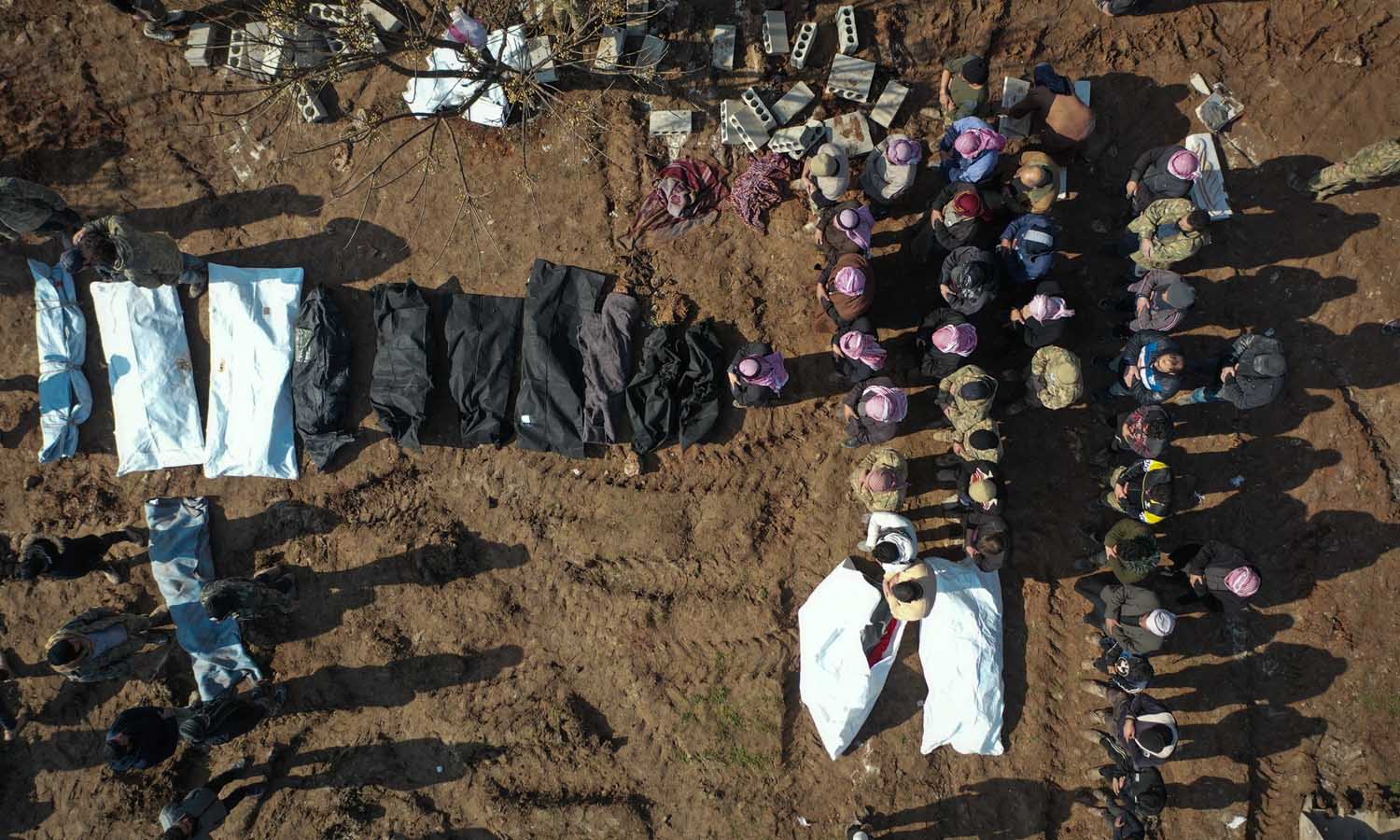
Worshipers perform funeral prayers for victims who died as a result of the earthquake that hit Syria and Turkey in Jindires north of Aleppo – February 8, 2023 (Syria Civil Defence)
As for Hussein (34), he could not benefit from the services of charity associations in Latakia to finance renting a house after his house collapsed due to the earthquake.
The young man and his family, consisting of a wife and two children who miraculously survived certain death the night of the earthquake, resorted to renting in the city of Jableh. Reluctantly, they chose living in one of the basements with unhealthy conditions for the children due to high humidity because its rent is less expensive for the family and does not exceed 250,000 Syrian pounds.
The family waited for more than ten months to receive temporary or alternative housing to no avail, and with the beginning of the current year, they moved to a healthier home at a monthly rent of 550,000 Syrian pounds, after the young man received help from his and his wife’s family, out of sympathy for his children’s situation.
Hussein tried knocking on all possible doors for assistance, but in vain. The restoration loan of 200 million Syrian pounds was unattainable as his demolished house is located in an area of informal housing, and the government’s promises to provide alternative housing were not fulfilled.

Damaged buildings following the Feb. 6 earthquake in al-Asaliya in Jableh city in Latakia countryside – February 1, 2024 (Enab Baladi/Linda Ali)
After years of the Syrian citizen facing alone the waves of price hike, the inability to secure the basic needs for his family, and the devaluation of the Syrian pound against foreign currencies, with the absence of any solutions to retrieve him from his consecutive crises, the earthquake was the knockout blow that finished off large segments of the Syrian people and their hopes to secure their basic needs.
Approximately 90% of Syrians live below the poverty line, with 15.3 million people in need of humanitarian aid. The average cost of living in regime-controlled areas is over 10.3 million Syrian pounds, and the minimum cost of living is 6.5 million pounds, while the minimum government wages do not exceed 186,000 Syrian pounds (1 USD = 14,650 pounds).
In northern Syria, where the opposition is in control, two million people are living in camps out of a total of 2.9 million displaced persons, in an area inhabited by 4.5 million people. There, 3.7 million people suffer from food insecurity, according to the latest United Nations data.
The poverty line was recognized at 9,314 Turkish lira, and the extreme poverty line at 6,981 Turkish lira, with the unemployment rate reaching an average of 88.74% (considering day laborers as part of the mentioned categories), while the minimum wage in Idlib where the Salvation Government controls and the rural areas of Aleppo where the Interim Government controls ranges between 1,140 and 1,500 Turkish lira (1 USD equals 30.2 Turkish lira).
In Northern Syria, humanitarian and relief organizations, volunteer teams, and the Salvation and Interim governorates share efforts to respond to the successive damages that affect the residents, but their ability is limited in front of a flood of consecutive natural and human disasters.
The Director of the Earthquake Victims Directorate in the Salvation Government, Ammar Najjar, told Enab Baladi that the number of earthquake victims reached 47,263 families. The Salvation Government, in partnership with international entities, was able to cover more than 12% of the affected families, due to the scarcity of UN support allocated for the northern Syrian regions.
Najjar stated that the Ministry of Development in the Salvation Government opened 114 shelters for the victims and provided more than 11,000 food baskets, 1,500 heaters, and over 1,800 emergency baskets, and transferred 5,000 families from shelters to concrete housing units, as well as moving 400 families from shelters to caravans and housed 60 orphaned families due to the earthquake in “Khayr At-Tujar” housing project and settled 30 families affected by the earthquake in the “Ajyal” residential project.
Najjar mentioned that the need is huge, and the residents still suffer from the aftermath of the earthquake to this day, with some still without homes or remaining within shelters established at the time of the earthquake, despite these centers not being created for permanent residence, but due to the lack of alternatives, they continue to live in them, adding that the ministry has devoted all its capabilities to serve the victims with modest support from humanitarian entities that do not match the magnitude of the affliction.
He emphasized that the current most important needs for the residents are securing permanent and decent housing for them, rebuilding houses damaged by the earthquake, finding work or a permanent source of income for those who lost their jobs and livelihood, and ensuring all types of material and in-kind support from food and emergency baskets to cash amounts.
Regarding obstacles facing the Salvation Government in implementing a permanent response, Najjar said that they are represented by the scarcity of financial resources sufficient for reconstruction, the repeated and continuous bombing by regime forces on the region, even reaching some of the camps housing earthquake victims, in addition to the narrow geographical area and the high population density, and the scarcity of job opportunities in the area.

Rescue teams and volunteer residents search for victims and survivors amidst the rubble of collapsed buildings following an earthquake that struck northwestern Syria in the village of Basnia near the city of Harem on the Syrian-Turkish border – February 7, 2023 (Enab Baladi/Mohammad Nasan Dabel)
A year after the earthquake, the Syria Civil Defence announced that it implemented a sanitation project in the Kafr Karmin and al-Kammouneh camps to service 7,000 temporary dwellings for earthquake victims and displaced persons, which included drinking water networks 50,000 meters long, and sewage networks 90,000 meters long.
The Civil Defence teams rehabbed and paved vital roads that stretch over 28 kilometers, began rebuilding a school in Jindires that accommodates 4,000 students, and worked on steps to restore dozens of damaged schools.
The teams started rehabbing about 20 medical facilities damaged by the earthquake and formed alliances to strengthen a healthier future for the communities, and assisted in repairing several places of worship, and building a mosque in the village of al-Maland west of Idlib.
Organizations, associations, and activists launched campaigns to support the earthquake victims in northern Syria, most of which were relief and in-kind materials, and few of them were directed towards renovation or constructing housing complexes and projects, among them a campaign launched by the Molham Volunteering Team operating in northern Syria and Turkey, titled the Earthquake Response Campaign, with the aim of collecting $20 million as a first stage for the reconstruction of 4000 homes, at a cost of $5,000 per home, in northwest Syria.
Molham Volunteering Team gathered more than $13 million within the campaign, an amount that roughly suffices to build 2,000 homes out of the 4000, considering that the cost of securing one home reaches about $5,000.
In July 2023, the team announced the first projects of the We Can Fund campaign named “Molham Residential Crescent” in the city of Harem north of Idlib, covering an area of 39,000 square meters, the complex consists of 25 buildings with 352 residential apartments, 16 commercial shops, and announced today, Tuesday, February 6, its opening.
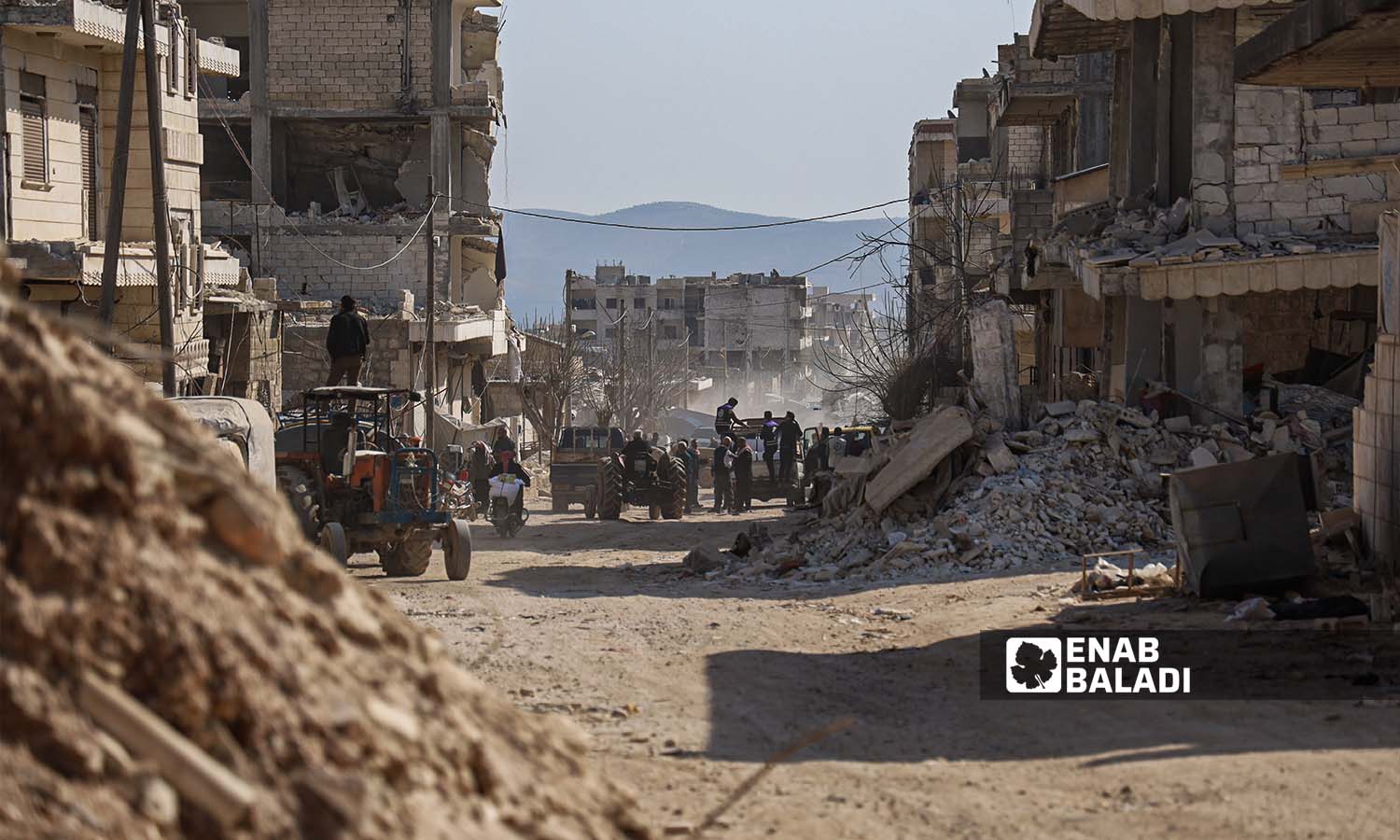
The streets of the city of Jindires in the countryside of Aleppo after the earthquake that hit northwest Syria – February 24, 2023 (Enab Baladi/Amir Kharboutli)
In response to the “disaster of the century,” the head of the Syrian regime, Bashar al-Assad, issued a decree establishing a financial fund named “The National Fund” to support the earthquake victims by providing financial support to address the physical or material or moral damages they suffered.
The decree specified the resources of the Fund to be from the allocations set in the general budget, from grants, aid, donations, and financial contributions of local and international character presented by states, organizations, institutions, companies, and individuals, and from the bank interests of the Fund’s deposits, provided that one or more accounts are opened for it at the operating banks.
A year after the earthquake, the regime government has not delivered any alternative homes to those who lost their dwellings due to the earthquake.
In Latakia governorate, the General Housing Establishment is constructing alternative houses for earthquake victims, without having completed them yet.
The Director of the General Housing Establishment branch in Latakia, Kenan Saeed, at the end of January, said that “good” progress is being made in the projects that the establishment is building by contracting with national construction companies such as the Military Construction and the Development and Construction Corporation.
The total projects in the governorate cover eight tower buildings comprising 320 apartments between Jableh and Latakia (each tower has 10 floors with 40 apartments in a standardized model of 100 square meters consisting of two rooms and a hall with complete interior finishing).
The first batch of apartments is expected to be delivered between April and May, and the rest between September and October, according to the director of the branch.
These apartments will benefit 150 people in Jableh and Latakia, who either own demolished dwellings in slum areas, those who have demolished homes in regulated areas, or those whose homes completely collapsed.
Nevertheless, no one in Latakia governorate can answer the question, what awaits the victims? Simply because no one knows, due to extreme centralization on the one hand, and due to clear negligence of this file on the other.
After asking many officials in the governorate and some municipalities, they agreed that they do not know anything yet and are waiting for instructions from Damascus, and they do not possess any information about the future of the victims.
Currently, there is a rumor circulating in Latakia governorate that the UAE decided to grant monetary sums to the victims, but there is nothing official in this regard, which means it might just be wishful thinking.

The debris of buildings damaged by the earthquake are still present in the city of Jableh in the Latakia countryside a year after its occurrence – February 2, 2024 (Enab Baladi/Linda Ali)
In the Aleppo governorate, the urban development plans and the follow-up on the significant damages that the earthquake left on buildings are not being implemented adequately, especially in the informal settlements of Aleppo city, amidst the routine procedures and bureaucracy that the Aleppo city council operates on.
The director of the General Establishment for Housing in Aleppo, Salem Habib, said that the completion rate of the al-Ma’saraniyah project, which includes the construction of four buildings with a total of 120 residential apartments, has reached 100% for the structural phase, noting that 22 billion Syrian pounds have been spent while the finishing work progresses by 70%. Meanwhile, the construction processes of the al-Haydariyah project, which includes the construction of four buildings with 320 residential apartments according to the plan set for it, are ongoing, according to him.
Last January, the Housing Minister in the regime’s government, Suhail Abdul Latif, was surprised by the pace of work of the relevant entities in Aleppo, specifically the Housing Establishment, in executing the residential buildings designated for the earthquake victims and the procedures followed by the city council of Aleppo and the Syndicate of Engineers regarding the inspection of the damaged buildings.
There was no actual accomplishment, specifically in the al-Haydariyah and al-Ma’saraniyah projects, which will be completed by the end of next March, while there is no actual achievement in terms of administrative work, demanding quick solutions to the problems that hinder the execution of the damaged buildings’ survey operations in Aleppo city.
A dispute prevails between the Aleppo city council and the Syndicate of Engineers, especially since a meeting held in the capital Damascus concluded two months ago to set a clear work plan and a clear formulation for all the points related to the sensory inspection and public safety reports and the compensation of the engineers. However, it seems that everything proposed in the meeting was not implemented despite the attendance of both the head of the Aleppo city council and the head of the Syndicate of Engineers.
Days after the earthquake occurred, the UN estimates indicated that about 8.8 million people in Syria are affected by the earthquake and need some form of humanitarian assistance.
The Deputy Special Envoy for Syria, Najat Rochdi, said at the time that 4.1 million people rely on humanitarian aid in northwest Syria to live, in addition to the four million people in Aleppo, Hama, Latakia, Tartus, and Idlib affected by the earthquake.
According to the data issued by the United Nations Office for the Coordination of Humanitarian Affairs (OCHA), the value of the humanitarian response plan for Syria for 2023 amounts to 5.41 billion US dollars, of which 1.79 billion dollars have been obtained so far, which means 33.1% of the needs have been met, until the end of December 2023.
The United Nations did not work on a clear program aimed at compensating the earthquake victims in terms of shelter, and the multi-purpose UN cash assistance, in particular, held a prominent place in Syria’s response to the earthquake due to the flexibility of local markets, and to enable families to buy what they need of their choice, all while stimulating the local economy.
Within a week of the earthquake, 1.8 million dollars in multi-purpose cash funds were distributed to 13,000 affected families, either homeless or displaced or in need of medical care. This support has increased significantly since that time, according to a report issued by the UN Office for the Coordination of Humanitarian Affairs (OCHA).
As of November 15, 2023, about 215,000 families (approximately one million people) have received multi-purpose cash funds worth 32 million dollars since the beginning of 2023.
Regarding the United Nations response in the shelter sector, the Deputy Spokesperson for the United Nations Office for the Coordination of Humanitarian Affairs (OCHA), Jens Laerke, told Enab Baladi that the United Nations took urgent action to respond and mobilize resources after the massive earthquakes, quickly launching an emergency appeal valued at 398 million US dollars to assist 4.9 million people in Syria who were affected by the earthquakes, and this appeal has been fully funded by donors, as well as the participation of the United Nations Central Emergency Response Fund.
This funding has provided food, shelter, first aid, psychological and social support for needy Syrians and helped in the critical task of debris removal, according to Laerke.
The annual humanitarian response plan for Syria for 2023, which was already in place, was also revised to 5.4 million dollars to accommodate the increasing humanitarian needs after the earthquake, and this plan received more than 2 billion dollars, according to Laerke.
Laerke explained that both appeals reflect the urgent need to provide additional shelter and housing for Syrians after the earthquakes, and more than half a million people in Syria received shelter support in 2023.
Even before the disaster occurred, the United Nations had an action plan to provide more temporary shelter units for those in need, and since March 2022, the United Nations has assisted more than 31,000 families, including those affected by the earthquakes.
However, there is still an urgent need for additional shelter support, and this will require increased funding for humanitarian response in Syria, according to the Deputy Spokesperson for the United Nations Office for the Coordination of Humanitarian Affairs (OCHA).
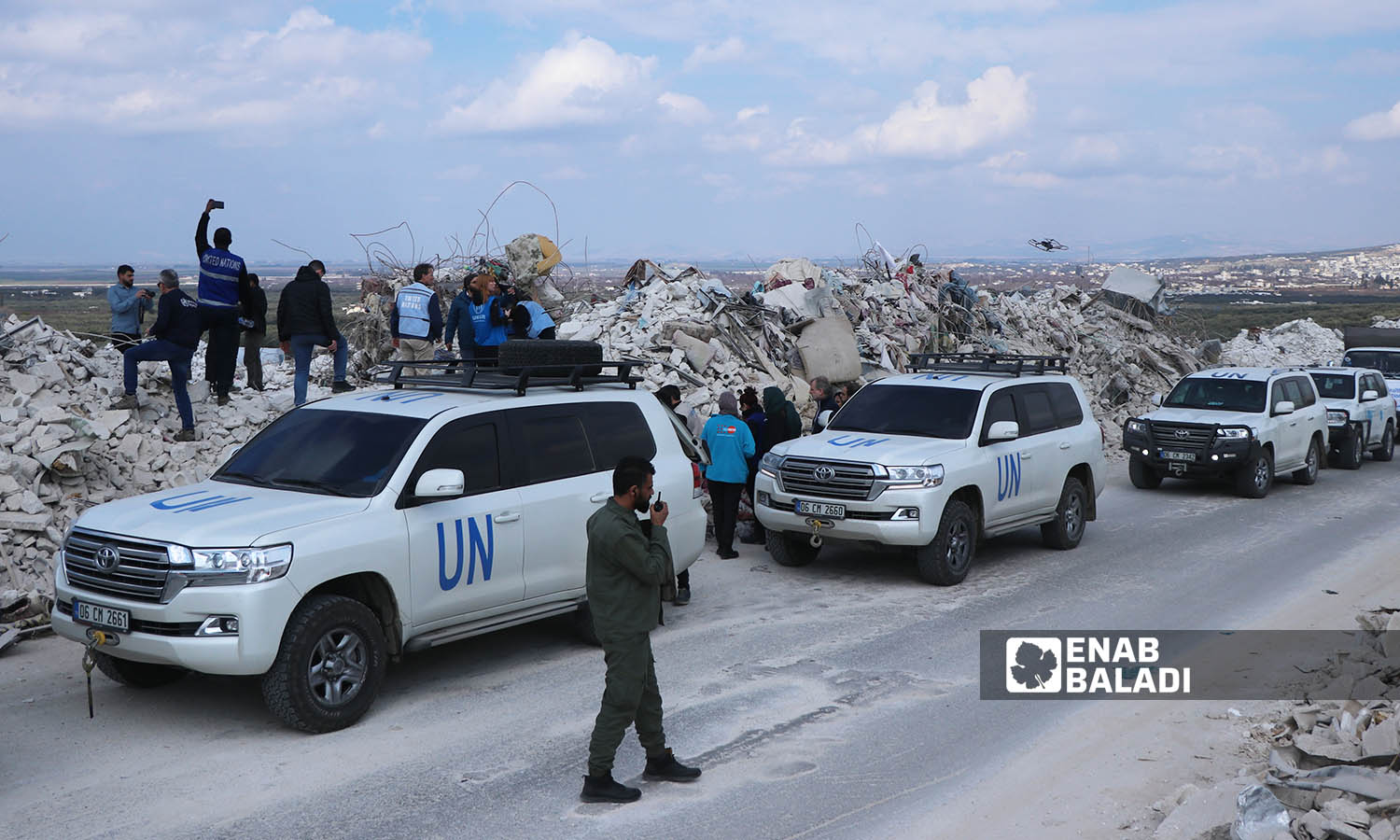
A UN delegation from various agencies during its visit to the earthquake-affected areas in the city of Harem in the countryside of Idlib – February 21, 2023 (Enab Baladi/Mohammad Nasan Dabel)
The European Union has provided relief humanitarian aid to the earthquake victims, which did not include alternative housing. On March 20, 2023, the European Commission held an emergency conference to cover humanitarian needs and assist in rebuilding the affected areas in Turkey, while the support for Syria will be allocated to help meet humanitarian needs and support early recovery.
Within this conference, international donors pledged within the “Donors Conference” to provide seven billion euros, including 950 million euros for Syria in the form of grants, and 6.05 billion euros in the form of grants and loans for Turkey.
In June 2023, at the Seventh Brussels Conference for “Supporting the Future of Syria and the Region,” the participating countries pledged a sum of 9.6 billion euros, in the form of grants and loans, to finance people in Syria and neighboring countries hosting Syrian refugees.
Daniel Puglisi, the press officer for humanitarian aid and crisis management at the European Commission, told Enab Baladi that for Syria, the European Union has mobilized more than 100 million euros, including 75 million euros in EU humanitarian aid, to support the life-saving emergency needs of vulnerable populations.
Puglisi explained that the European Union sent supplies from the European Humanitarian Response Capacity (EHRC) warehouses in Brindisi and Dubai, aiming to support relief efforts across the country.
Furthermore, the European Union Civil Protection Mechanism mobilized assistance from 16 European countries, which was transported by trucks through Lebanon and Turkey to government and non-government-controlled areas in Syria.
On March 17, 2023, the World Bank estimated in its report that the material damages caused by the earthquake in Syria were about 3.7 billion US dollars, while the losses are estimated at about 1.5 billion dollars, bringing the total estimated impact to 5.2 billion dollars.
The report stated that the losses caused by the earthquake include a decrease in production in productive sectors, loss of revenue, and increased operational costs in providing services.
The housing sector was considered the most affected (24% of the total damages) followed by the transport sector and the environment sector related to the cost of debris removal, and then the agriculture sector.
According to the report, the recovery and reconstruction needs across the assessed governorates amount to 7.9 billion US dollars, with the first-year post-earthquake requirements estimated at approximately 3.7 billion US dollars, and 4.2 billion US dollars for the following two years.
The agriculture sector recorded the highest needs (27% of the total needs), followed by housing (18%), social protection (16%), and transportation (12%).
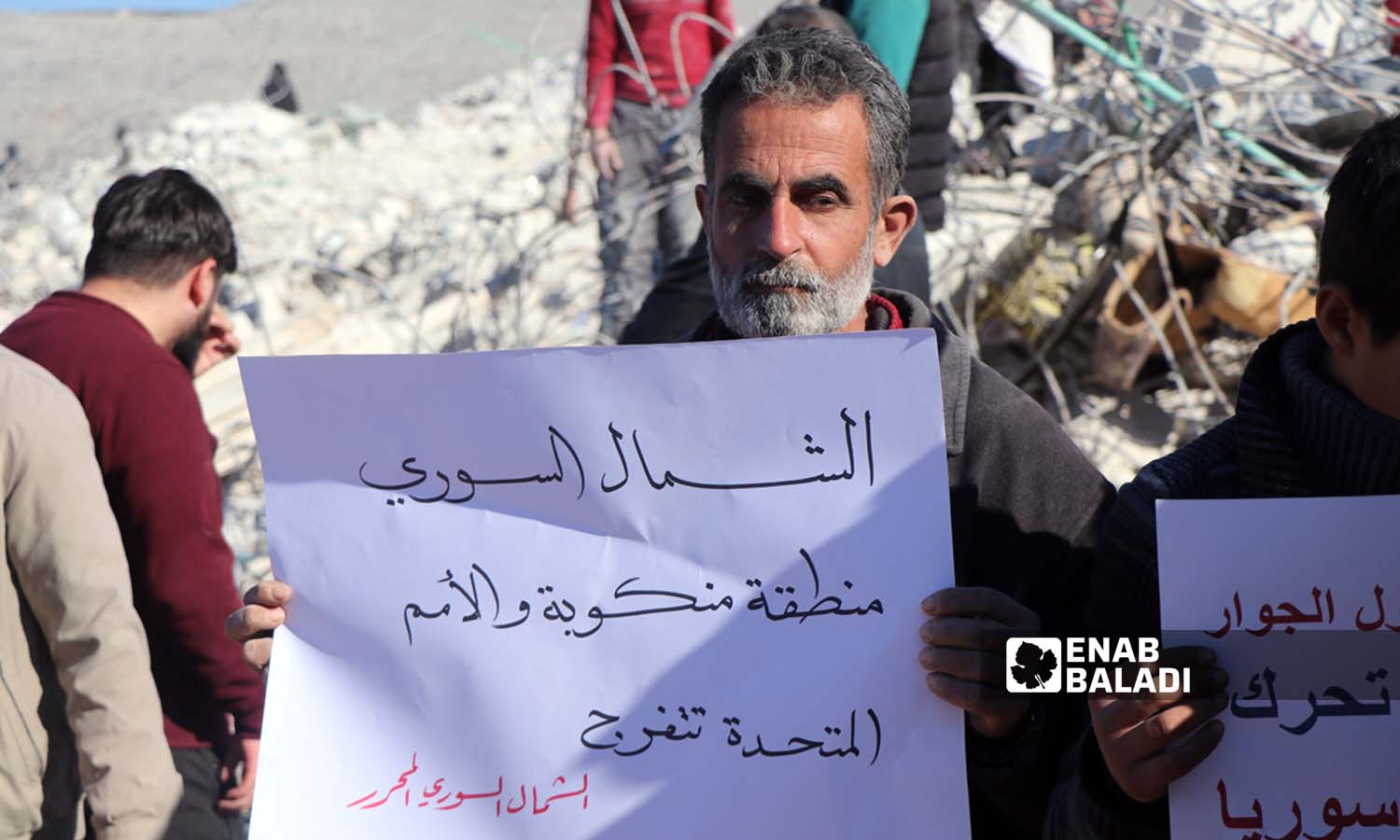
Protesters in the village of Basnia in rural Idlib demand the international community to stand with the affected and to facilitate the entry of aid into areas devastated by the destructive earthquake that struck northwestern Syria – February 9, 2023 (Enab Baladi/Mohammad Nasan Dabel)
if you think the article contain wrong information or you have additional details Send Correction